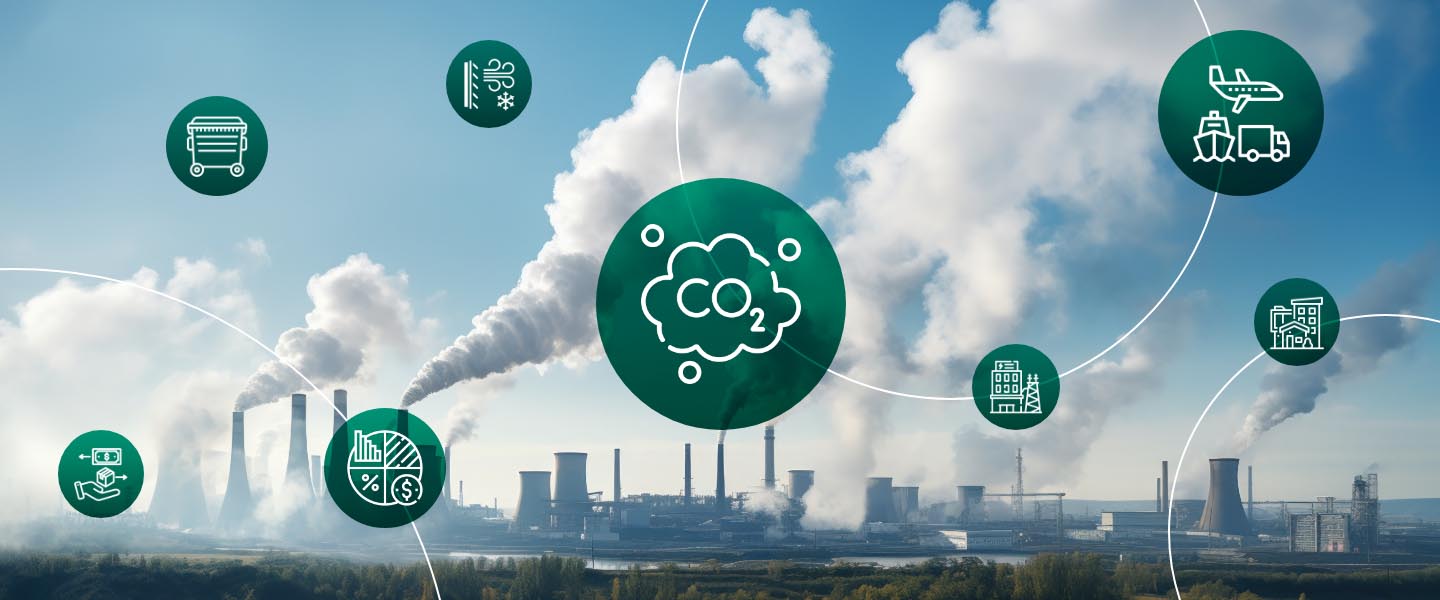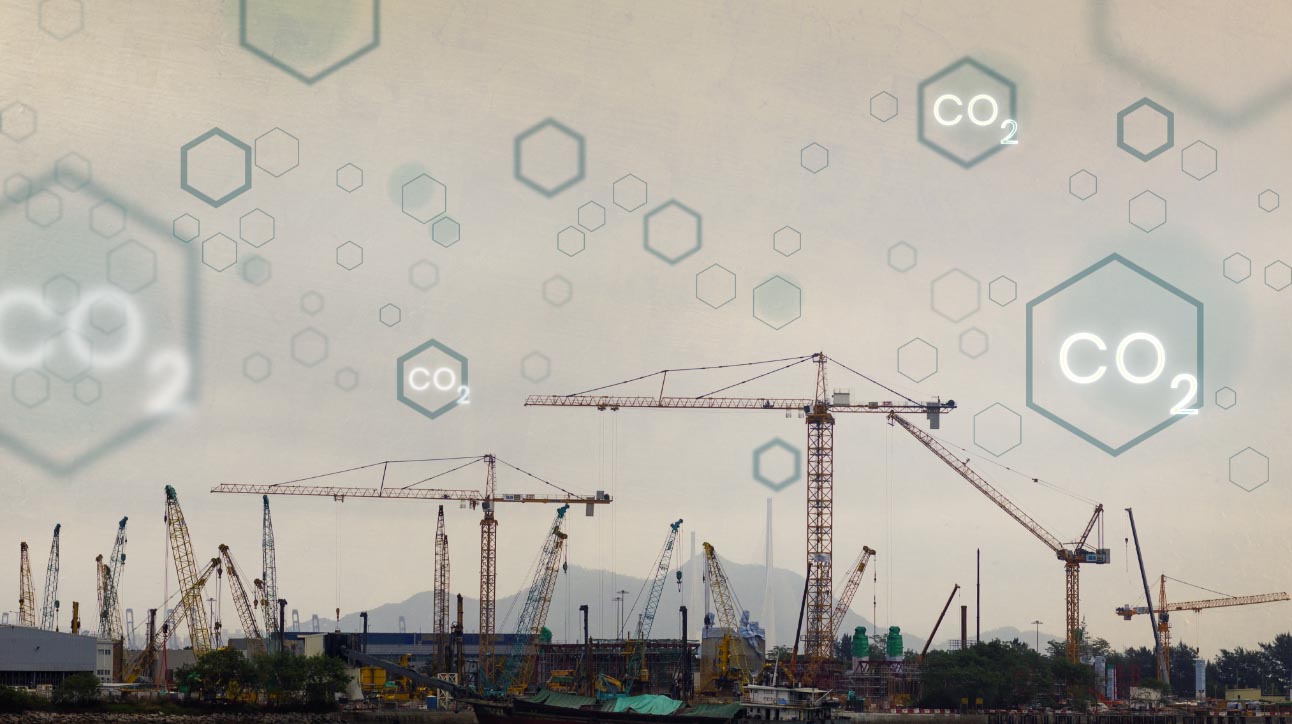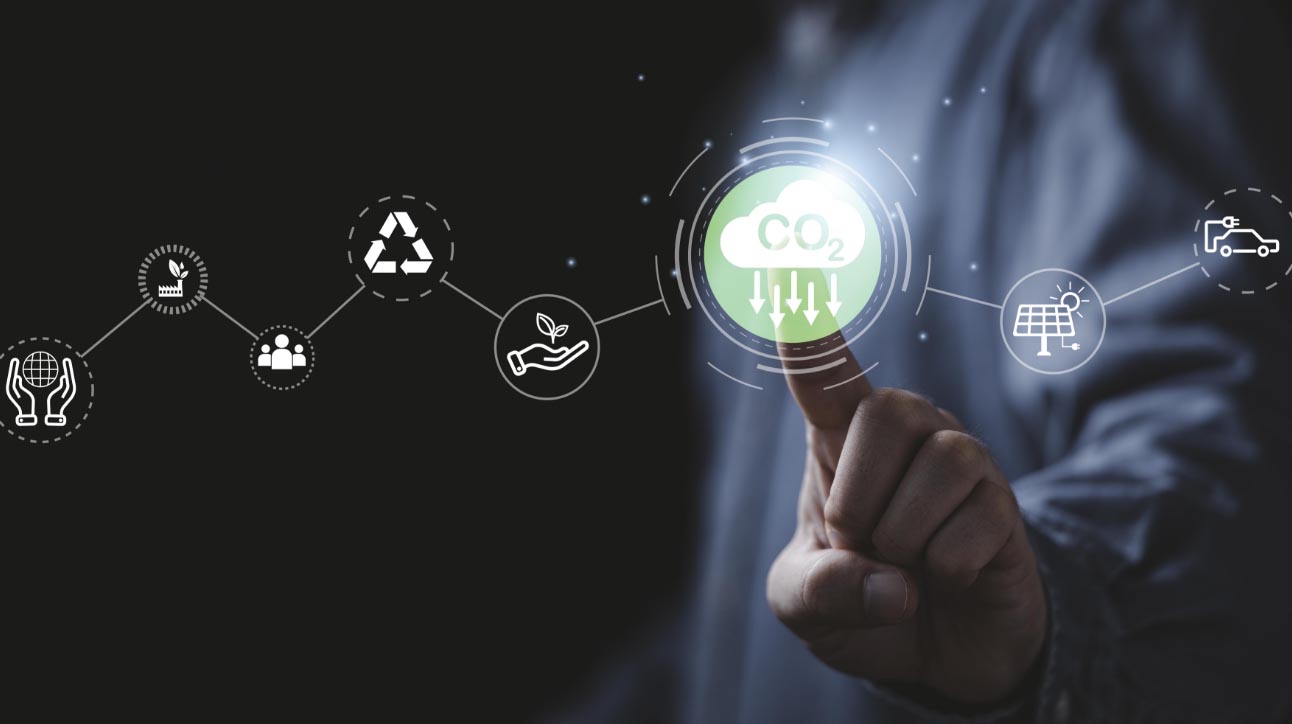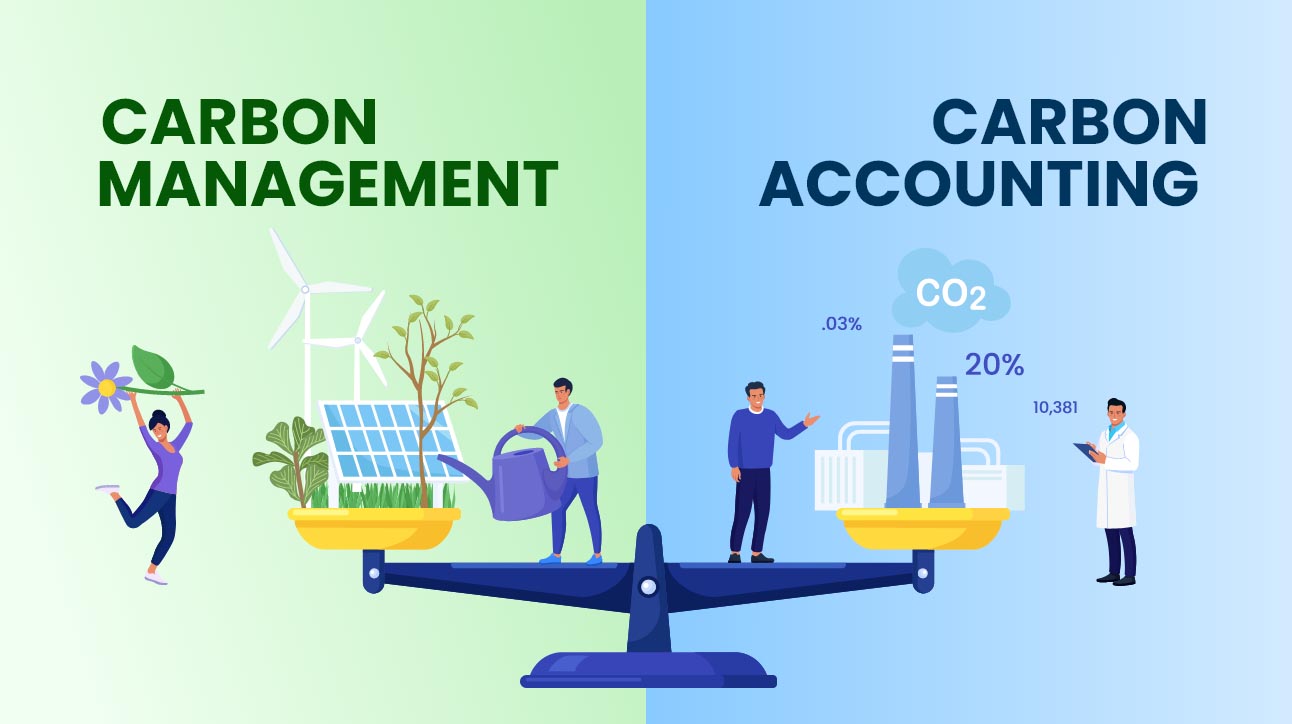Decarbonisation, or reducing carbon dioxide (CO2) levels, is essential in addressing climate change. For businesses, carbon emissions contribute to their overall carbon footprint, which reflects their environmental impact. However, most companies often struggle to determine which emissions to report.
The Greenhouse Gas (GHG) Protocol simplifies this by classifying into three categories: Scope 1, 2, 3 emissions. These categories are based on the source of the emissions. The GHG protocol enables businesses to track and manage emissions through tools like carbon footprint calculators and reporting practices. This guide covers what these emissions are, scope 1, 2 & 3 emissions examples, and how accountability can be increased with a carbon footprint calculator to better manage emissions.
Scope 1, 2, and 3 Emissions Explained
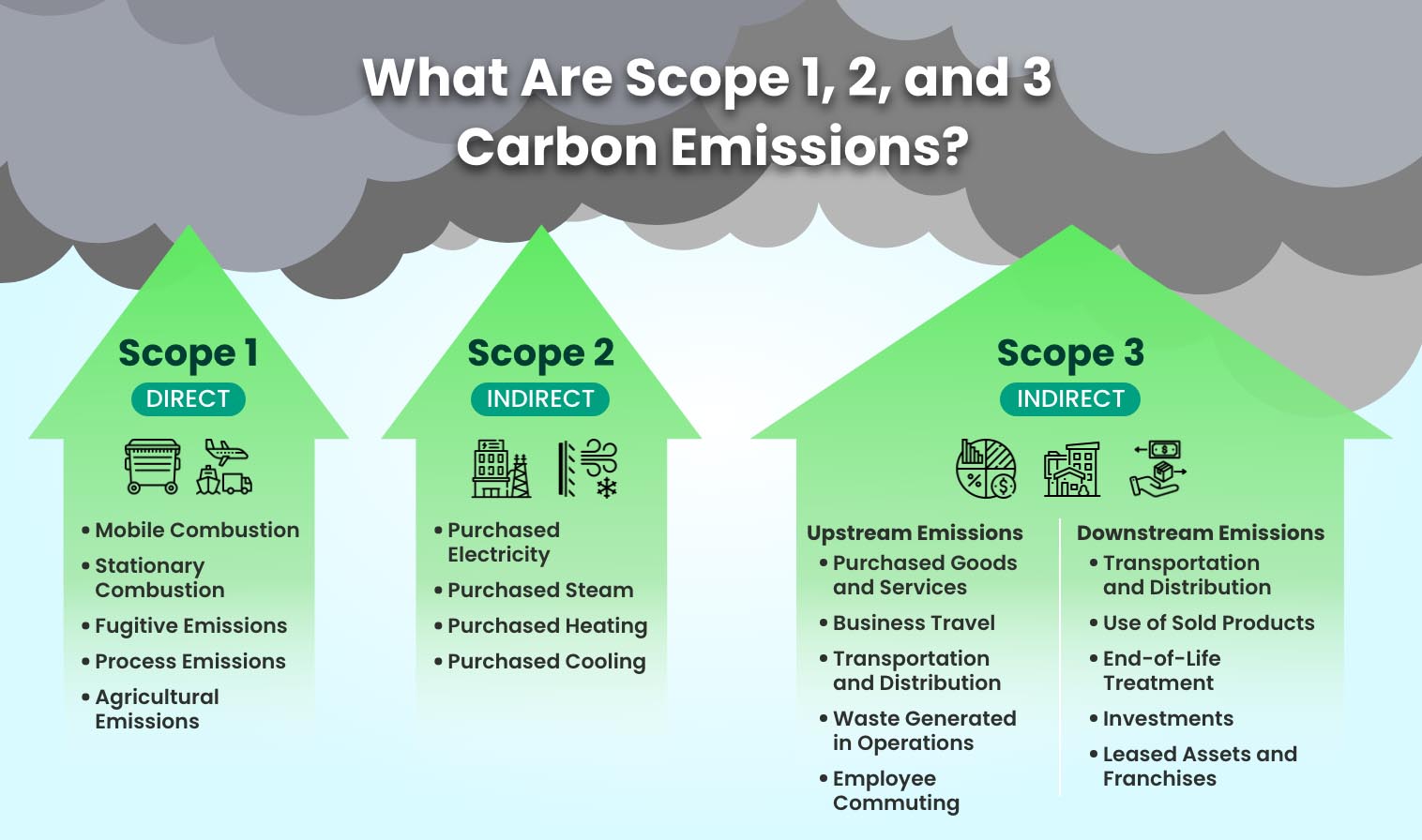
According to the GHG Protocol, carbon emissions are to be classified under three scopes based on who is ultimately responsible for their release into the atmosphere. Under most carbon emissions reporting standards and legal frameworks, only scopes 1 and 2 must be reported, although there is growing support for expanding standards to include scope 3.
What are Scope 1 Emissions?
Scope 1, or direct emissions, are greenhouse gas emissions from sources a company owns or directly controls. These emissions are produced through on-site activities or operations, making them the most immediate and tangible form of emissions for businesses to address.
While Scope 1 covers direct emissions, there are certain exclusions to note. For example, CO₂ emissions from biomass combustion must be reported separately because they are not included in Scope 1 totals. Gases not covered by the Kyoto Protocol, such as chlorofluorocarbons (CFCs) or nitrogen oxides (NOx), should also be excluded from Scope 1 reporting and listed separately.
Examples of Scope 1 Emissions
Scope 1 emissions can be grouped into several main categories, which highlight the different ways businesses directly contribute to greenhouse gas emissions:
- Mobile Combustion
Emissions from company-owned or controlled vehicles and equipment, such as delivery trucks, service cars, and forklifts. - Stationary Combustion
Emissions produced by burning fuel in stationary equipment like boilers, furnaces, and generators. - Fugitive Emissions
Gases that escape unintentionally during operations, such as refrigerant leaks from air conditioning systems or methane leaks in pipelines. - Process Emissions
Emissions released as a byproduct of industrial processes, such as the production of cement, steel, or chemicals. - Agricultural Emissions
Emissions from agricultural operations, including methane from livestock and nitrous oxide from fertiliser use.
How to Calculate Scope 1 Emissions
- Identify Emission Sources
List all sources of direct emissions under the company’s control. This includes:- Vehicles and machinery that burn fuel
- Boilers, furnaces, or generators on-site
- Chemical processes that produce CO₂
- Equipment prone to gas leaks, like HVAC systems
- Collect Activity Data
Measure how much fuel is burned, how much material is processed, or how much gas has leaked. Activity data is usually tracked in units like litres, gallons, kilograms, or cubic meters. Examples includes:- Litres of fuel used in company vehicles
- Kilograms of refrigerant gases lost
- Tonnes of cement produced
- Use Emission Factors
Multiply the activity data by emission factors, which are standard values that estimate emissions per unit of activity. These factors are provided by organisations like the Intergovernmental Panel on Climate Change (IPCC) or national agencies.
Example Calculation: If 1,000 litres of diesel fuel are burned, and the emission factor for diesel is 2.68 kg CO₂ per litre:
1,000 liters × 2.68 kgCO2/litre = 2,680 kgCO2 - Summarise and Report
Add up emissions from all sources to get the total Scope 1 emissions. Report the data according to recognised frameworks like the Greenhouse Gas (GHG) Protocol.
What are Scope 2 Emissions?
Scope 2 emissions, or indirect emissions, result from generating energy purchased and consumed by a company. These emissions occur outside the organisation’s physical operations but are directly tied to its energy use. The most common sources include greenhouse gases produced during the generation of electricity, heating, cooling, or steam that a company procures to power its facilities.
While Scope 2 emissions are generated offsite, businesses are still accountable for them as they depend on external suppliers for their energy needs. Reducing Scope 2 emissions often involves improving energy efficiency and sourcing renewable or low-carbon energy alternatives.
Examples of Scope 2 Emissions
Scope 2 emissions primarily stem from purchased energy sources that power operations:
- Purchased Electricity
Emissions resulting from the production of electricity consumed by an organisation, whether for offices, manufacturing plants, or warehouses. - Purchased Steam
Emissions generated during the production of steam used for industrial processes or heating systems. - Purchased Heating
Emissions tied to energy produced for heating purposes, such as district heating systems serving office buildings. - Purchased Cooling
Emissions related to energy consumed for cooling purposes, such as district cooling systems or central air conditioning supplied externally.
How to Calculate Scope 2 Emissions
Scope 2 emissions are calculated by multiplying the energy consumed by its corresponding emission factor, which represents the greenhouse gases emitted per unit of energy generated. Here’s a simplified approach:
- Determine Energy Consumption
Collect data on the total amount of purchased electricity, steam, heating, and cooling consumed over a defined period (e.g., kilowatt-hours for electricity). - Identify Emission Factors
Use location-based emission factors (specific to the energy grid in a region) or market-based factors (e.g., factors associated with energy purchased through green power contracts). Reliable sources include: - Apply the Formula
Scope 2 Emissions = Energy Consumed × Emission FactorFor example, if a company consumes 100,000 kWh of electricity and the emission factor for their grid is 0.5 kg CO₂e/kWh, the calculation would be:100,000 kWh × 0.5 kgCO2e/kWh = 50,000 kgCO2e (50 metric tonnes) - Account for Renewable Energy
If renewable energy certificates (RECs) or guarantees of origin (GOs) are used, businesses can adjust their market-based emissions to reflect these purchases.
What are Scope 3 Emissions?
Scope 3 emissions include all indirect greenhouse gas emissions that occur in a company’s value chain but are not directly produced or controlled by the organisation. Unlike Scope 1 and Scope 2 emissions, Scope 3 encompasses a broad range of activities both upstream (before a product or service is delivered) and downstream (after delivery). These emissions arise from processes like material extraction, manufacturing, transportation, product use, and disposal.
As Scope 3 emissions often represent the largest portion of a company’s total carbon footprint, addressing them is vital for meaningful decarbonisation efforts. Companies must work closely with suppliers, customers, and partners to measure and reduce these emissions.
Upstream Emissions
Upstream emissions are generated from processes and activities that occur before a company’s direct operations, such as material sourcing, production, and transportation of goods or services:
- Purchased Goods and Services: Emissions from the production of raw materials, components, or services purchased by the company.
- Business Travel: Emissions generated from employee travel, such as flights, trains, and car rentals.
- Transportation and Distribution: Emissions from transporting goods and materials to the company, including suppliers’ logistics.
- Waste Generated in Operations: Emissions from waste disposal, including recycling and landfill processes.
- Employee Commuting: Emissions produced by employees travelling to and from work.
Downstream Emissions
Downstream emissions result from activities that occur after a product or service has left a company’s control, such as product distribution, use, and disposal:
- Transportation and Distribution: Emissions from distributing and delivering finished products to customers.
- Use of Sold Products: Emissions that arise when customers use the products, such as fuel consumption in vehicles.
- End-of-Life Treatment: Emissions resulting from the disposal, recycling, or incineration of sold products.
- Investments: Emissions associated with investments and financial activities, such as portfolios or holdings.
- Leased Assets and Franchises: Emissions from leased facilities, vehicles, or franchised operations not included in Scope 1 or 2.
How to Calculate Scope 3 Emissions
Calculating Scope 3 emissions is more complex due to the wide range of activities involved and the reliance on third-party data. The Greenhouse Gas Protocol outlines a systematic approach for calculating Scope 3 emissions:
- Identify Relevant Scope 3 Categories
- Determine which of the 15 Scope 3 categories apply to your organisation based on your value chain activities (e.g., purchased goods, business travel, product use).
- Collect Activity Data
- Use primary data from suppliers, transportation providers, and internal operations where possible.
- When primary data is unavailable, use secondary data, such as industry averages, emission factors, and life cycle assessments.
- Apply Emission Factors
- Multiply the collected activity data (e.g., distance travelled, energy consumed, materials purchased) by appropriate emission factors. Emission factors can be sourced from:
- Greenhouse Gas Protocol
- EPA Emission Factors Hub
- International Energy Agency (IEA)
- Life Cycle assessment databases (e.g., Ecoinvent, DEFRA)
- Multiply the collected activity data (e.g., distance travelled, energy consumed, materials purchased) by appropriate emission factors. Emission factors can be sourced from:
- Formula:
Scope 3 Emissions = Activity Data × Emission Factor
Example: If a company purchased 10,000 kg of steel with an emission factor of 1.8 kg CO₂e per kg, the calculation is:
10,000 kg × 1.8kg CO2e/kg = 18,000 kgCO2e (18 metric tonnes) - Estimate and Report
- Use tools like the GHG Protocol’s Scope 3 Evaluator Tool or other carbon accounting platforms to consolidate data.
- Include uncertainties and assumptions transparently in reporting.
Scope 1, 2, and 3 Inventory Guidance
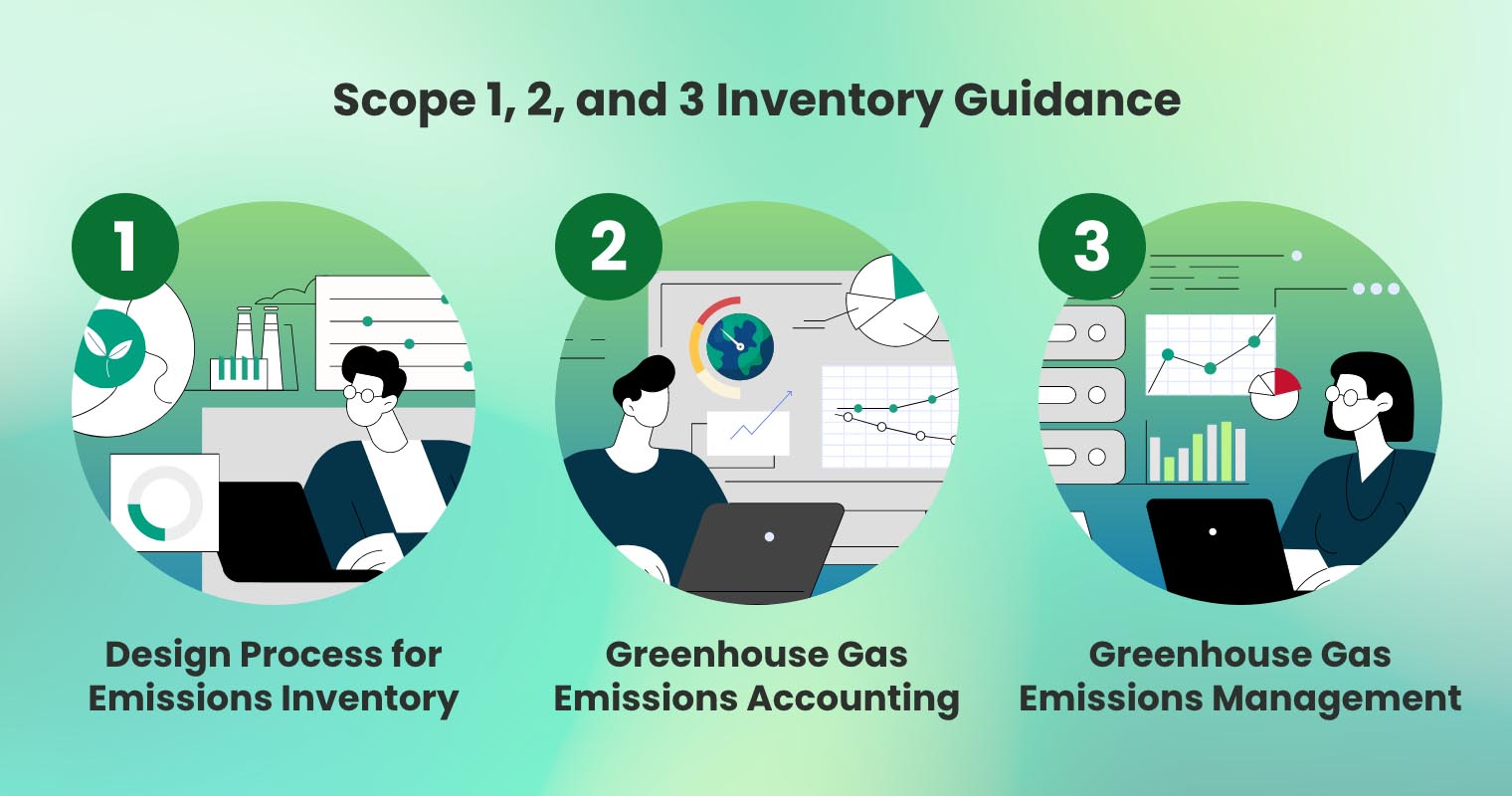
Establishing an inventory for Scope 1, Scope 2, and Scope 3 emissions requires a structured approach that evolves as the organisation matures in its sustainability efforts.
The stages of engagement for each scope can be broken down into four levels – no activity, entry-level, intermediate, and advanced.
At the No Activity stage, no efforts are made to track or manage emissions. The Entry-Level stage involves basic tracking, often through estimations, with some emissions being measured but not formally reported. At the Intermediate stage, companies report emissions more systematically and may start reducing Scope 1 and 2 emissions, with some focus on Scope 3. The Advanced stage includes comprehensive, verified reporting for all scopes, with active emission reduction strategies, regular third-party audits, and a strong emphasis on transparency.
- Design Process for Emissions Inventory
The first step in designing an emissions inventory is determining the organisation’s current level of engagement with Scope 1, 2, and 3 emissions. Companies typically start by assessing their existing operations, identifying major emission sources, and setting clear goals for emissions reporting and reductions. - Greenhouse Gas Emissions Accounting
The next step involves calculating emissions for each of the three scopes. Companies should use the GHG Protocol or other recognised standards to calculate emissions in each scope.
Depending on the engagement stage, the level of detail in accounting for Scope 3 emissions will vary. Early-stage companies may only calculate emissions for some upstream or downstream activities, while advanced organisations will aim to include all relevant categories of emissions across their value chain. - Greenhouse Gas Emissions Management
As organisations advance through the stages of engagement, the focus of emissions management shifts from basic calculation to strategic management and reductions. At the entry level, organisations might track and disclose only major sources of emissions. Intermediate organisations start to implement reduction strategies, engage suppliers, and aim to reduce Scope 1, 2, and 3 emissions through energy efficiency and process improvements. Advanced organisations take a proactive approach, ensuring continuous engagement with suppliers, setting reduction targets, and implementing low-carbon technologies across their operations.A key part of managing emissions is verification. As companies advance, they should seek third-party verification to ensure the accuracy and reliability of their emissions data. Verification helps enhance transparency and accountability, building trust with stakeholders and regulatory bodies.
How to Reduce Scope 1, 2, and 3 Emissions
Scope 1: Minimising direct emissions
Reducing Scope 1 emissions can be challenging due to the direct involvement of a company’s operations. Sure, these emissions are within the company’s direct control. However, reducing them may require significant capital investment, such as upgrading equipment or transitioning to renewable energy sources.
That said, it isn’t impossible. To reduce Scope 1 emissions, companies can focus on improving energy efficiency, transitioning to cleaner fuels, and adopting low-carbon technologies.
For example, switching from fossil fuels to renewable energy sources (e.g., wind or solar) for manufacturing processes or company vehicles can significantly cut emissions. Improving energy efficiency in facilities and using carbon capture and storage (CCS) technologies are also effective strategies.
Additionally, companies can invest in fleet electrification or explore low-carbon alternatives like hydrogen for high-emission sectors like heavy industry or transportation.
Scope 2: Managing indirect emissions from purchased energy
Scope 2 emissions arise from the electricity, heating, and cooling that a company purchases. The challenges include the availability of low-carbon energy sources in certain regions and the need to collaborate with energy providers to secure renewable energy contracts. Additionally, Scope 2 emissions can vary significantly depending on the country or region due to differences in grid carbon intensity.
To address these emissions, the focus should be on improved energy procurement strategies. Google, for example, has achieved 100% renewable energy for its global operations since 2017. By transitioning its data centres and offices to renewable sources and entering into power purchase agreements (PPAs), Google supports new clean energy projects and drastically reduces its Scope 2 emissions.
Scope 3: Indirect Emissions from the Value Chain
Scope 3 emissions are the most difficult to manage, as they stem from the broader supply chain, product usage, and even customer behaviours. Companies have limited control over these emissions and face challenges in collecting accurate data from upstream and downstream partners.
The key to learning how to reduce Scope 3 emissions is collaboration. Companies can start by engaging with suppliers to encourage the use of sustainable materials and low-carbon processes. Conducting life-cycle assessments (LCAs) to identify high-emission hotspots in the supply chain allows companies to target specific areas for improvement. Encouraging customers to adopt low-carbon product use behaviours or to recycle products at the end of life also contributes to Scope 3 reduction.
GHG Protocol Corporate Standard Reporting Requirements
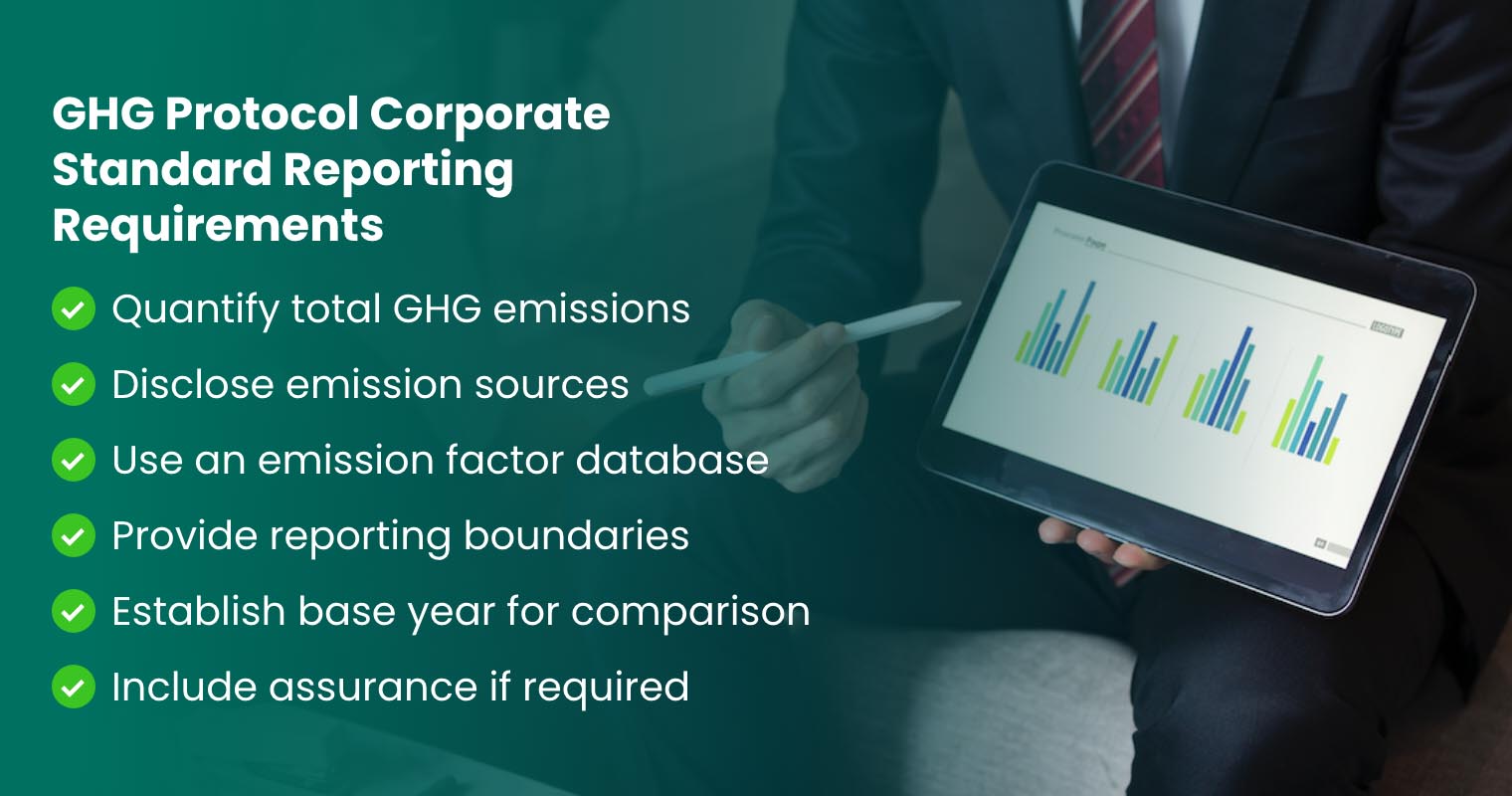
The GHG Protocol Corporate Standard provides a framework for businesses to measure and manage their greenhouse gas emissions, divided into Scope 1, Scope 2, and Scope 3 emissions.
Any company or organisation that meets the reporting thresholds for GHG emissions is required to submit an emissions report. Reporting is often mandatory for publicly listed companies and those that are part of regulatory frameworks or sustainability indices.
For example, in the US, the Environmental Protection Agency (EPA) mandates that companies emitting more than 25,000 metric tons of CO2 equivalent (CO2e) annually must report their emissions under the Greenhouse Gas Reporting Program (GHGRP).
In Singapore, companies listed on the Singapore Exchange (SGX) are required to report their sustainability performance, including GHG emissions, as part of the SGX sustainability reporting requirements. Similarly, in Hong Kong, the Stock Exchange of Hong Kong (HKEX) mandates that listed companies disclose their GHG emissions under the ESG reporting guidelines.
The GHG Protocol Corporate Standard specifies that emissions reports should include a detailed breakdown of Scope 1, 2, and 3 emissions. Companies must also:
- Quantify total GHG emissions: Provide the total amount of emissions from each scope, typically expressed in metric tons of CO₂-equivalent (CO₂e).
- Disclose emission sources: Emissions sources must be identified and detailed, including fuel consumption, energy use, and supply chain activities.
- Use an emission factor database: Apply appropriate emission factors to convert activity data (e.g., energy usage or fuel consumption) into CO₂e emissions.
- Provide reporting boundaries: Define organisational boundaries based on operational control, financial control, or equity share.
- Establish base year for comparison: Organisations should set a baseline year to compare emissions data over time, tracking progress in emission reduction efforts.
- Include assurance if required: Many companies opt for third-party verification of emissions data, which enhances credibility and ensures compliance with reporting standards.
FAQs
- Why should a company measure Scope 1, 2, and 3 emissions?
Measuring Scope 1, 2, and 3 emissions helps businesses fully understand their carbon footprint and identify areas to reduce emissions. By tracking all three, companies can optimise energy use, reduce waste, engage suppliers in sustainability, and design greener products. Moreover, measuring these emissions ensures compliance with reporting standards and prepares businesses for the transition to a low-carbon economy. - What is the difference between direct and indirect emissions?
Direct emissions (Scope 1) come from sources owned or controlled by a company, such as fuel combustion in vehicles or manufacturing processes. Indirect emissions (Scope 2 and 3) are a result of a company’s activities but occur outside its direct control. Scope 2 emissions are from purchased energy like electricity, while Scope 3 includes all other indirect emissions, such as those from supply chain activities or product use. - What are Scope 4 emissions?
Scope 4 emissions, often referred to as “avoided emissions,” are not officially part of the GHG Protocol. These emissions represent reductions achieved by a company through low-carbon technologies or sustainable practices, such as renewable energy adoption or energy-efficient products. While not counted in the traditional scope structure, Scope 4 can play an important role in demonstrating a company’s broader environmental impact and its efforts to prevent emissions elsewhere in the value chain. - Is reporting Scope 1, 2, and 3 emissions mandatory for companies?
While many companies are required to report Scope 1 and 2 emissions based on local regulations (such as the EU’s Non-Financial Reporting Directive or the SEC’s rules), Scope 3 reporting is generally voluntary. However, increasing pressure from stakeholders, including investors, customers, and regulatory bodies, is prompting more companies to voluntarily report Scope 3 emissions to demonstrate a comprehensive commitment to sustainability. - How can organisations set targets for Scope 1, 2, and 3 emissions?
Organisations can set emission reduction targets by using frameworks like Science-Based Targets (SBTi) or by aligning with the UN’s Sustainable Development Goals (SDGs). For Scope 1 and 2, targets might focus on improving energy efficiency, transitioning to renewable energy, or reducing resource consumption. For Scope 3, companies often work with suppliers to minimise emissions in the value chain, whether by sourcing sustainable materials or optimising product usage and disposal.
Measuring and Reporting Scope 1, 2, and 3 Emissions with Convene ESG
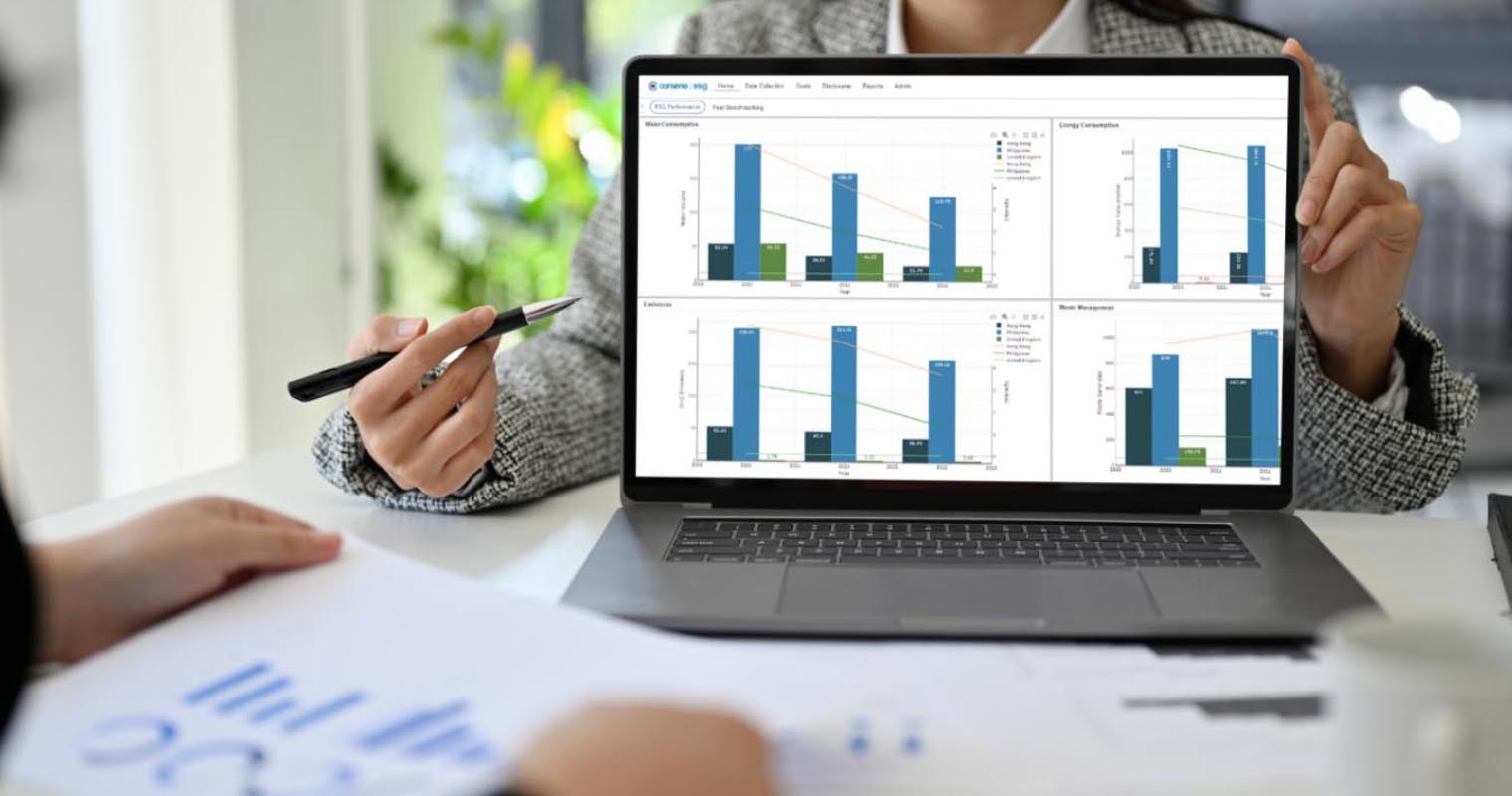
Monitoring Scope 1, 2, and 3 carbon emissions is essential to your company’s sustainability, but it can also be challenging. That’s where Convene ESG comes in. Convene ESG is an ESG software that gives users the ability to understand, measure, and report their carbon output, while also identifying strategies for reducing emissions across all scopes.
Convene ESG simplifies ESG reporting with automated data workflows, customisable reporting templates, and full compliance with mandatory requirements. Its dashboards track performance, set goals, and provide oversight to ensure transparency, all while adapting to evolving reporting needs. It also measures Scope 1, 2, and 3 emissions using global standards and customisable emission factors, offering a comprehensive scope emissions dashboard for easy tracking and reporting.
Schedule your demo today to learn more about the leading ESG reporting software, Convene ESG.
Joseph is a graduate of Environmental Science with a minor in Sustainability. Post-grad he conducted research on sustainability targeting coastal cities in the Philippines and assessing their environmental and socio-ecological factors. His most recent experience involves ESG data collection and ESG data mapping.
